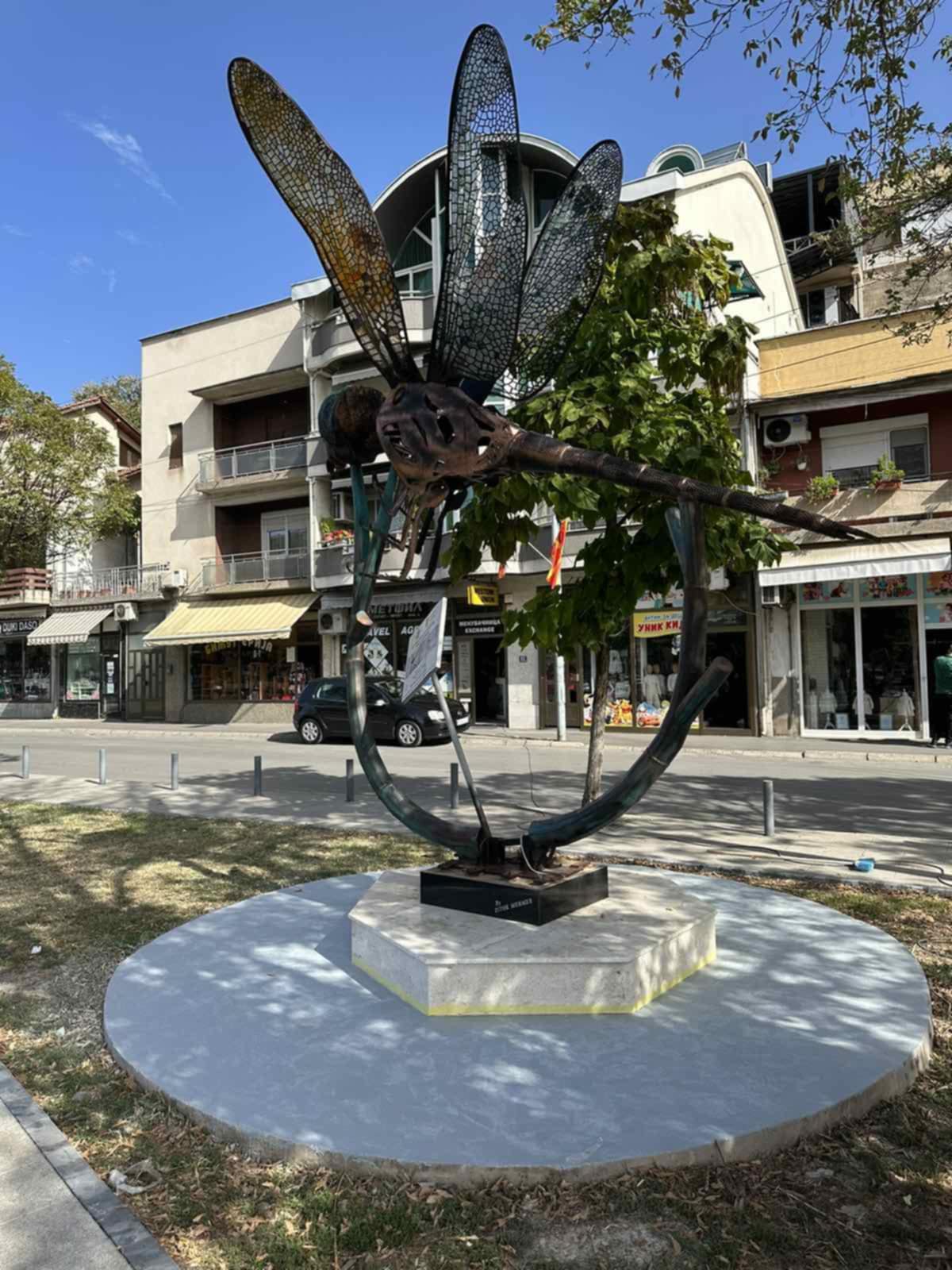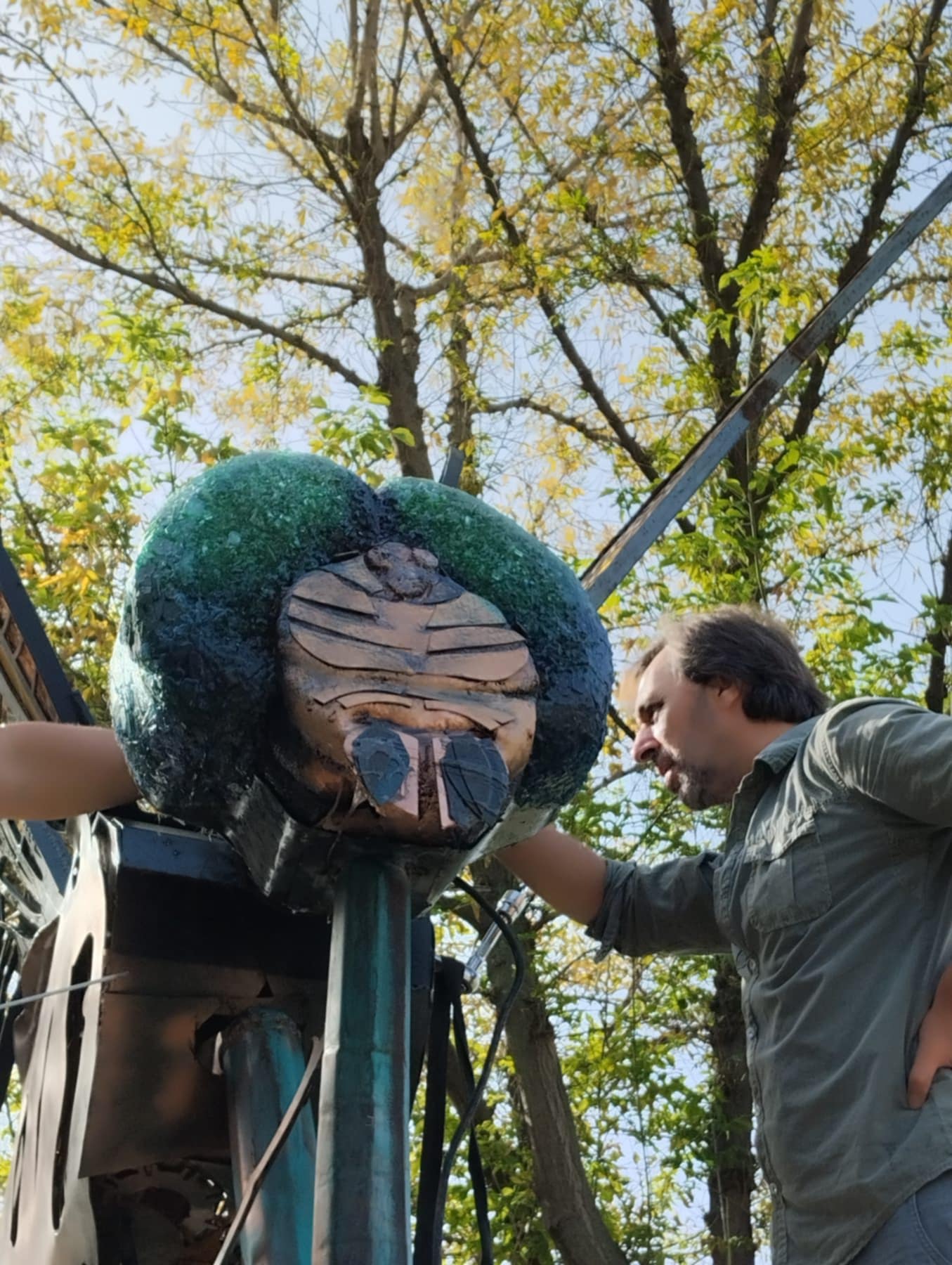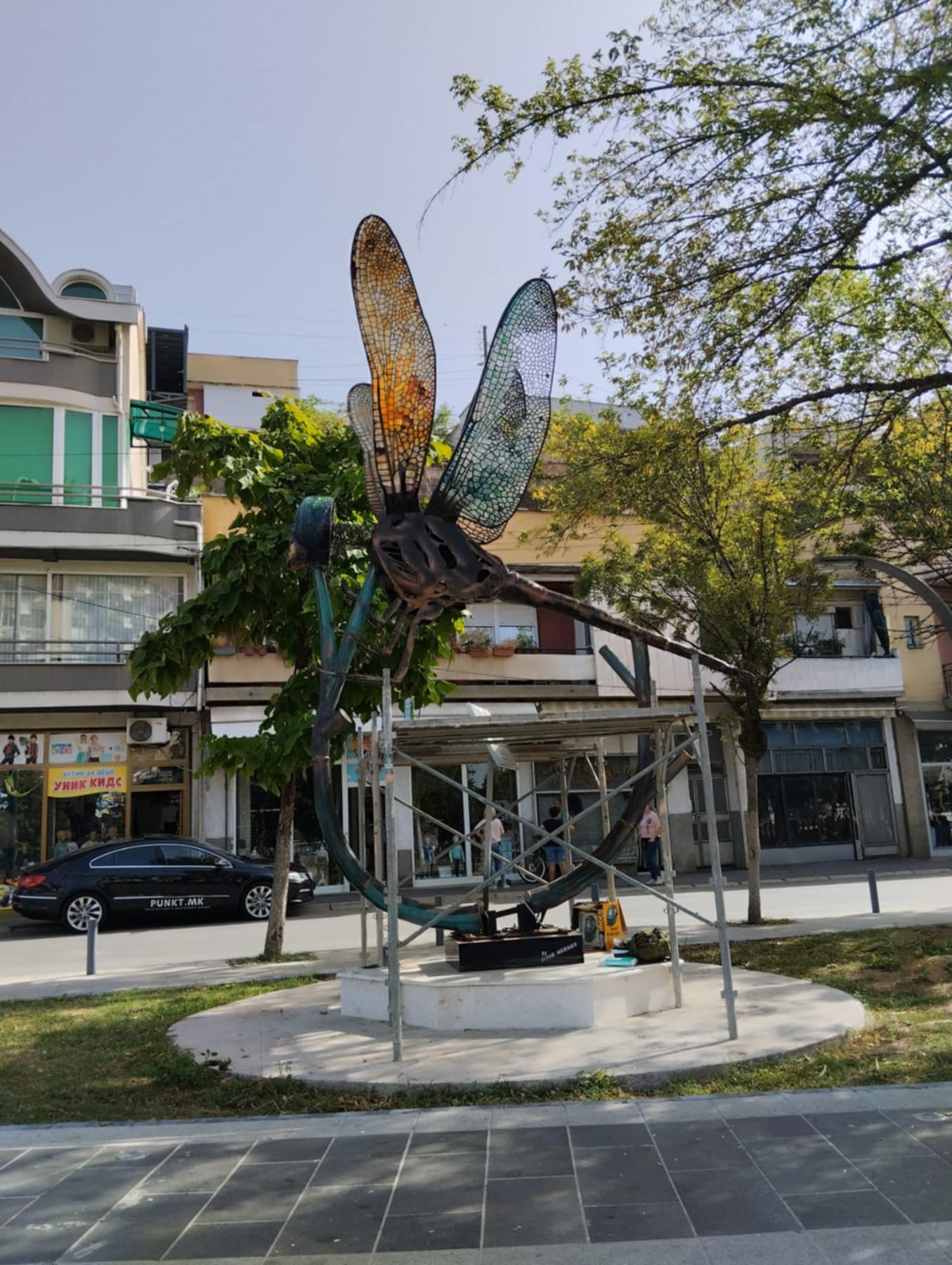Reconnecting with nature
Dragonfly Monument
Dragonfly Monument
The Dragonfly Monument is a sculptural solution, placed in the Park of the Revolution in Kočani (North Macedonia) which initiates a message of environmental protection through one of the biggest indicators of a clean environment - the dragonfly! This insect, which is on the verge of extinction in the vicinity of Kočani, has been immortalized through the Monument, made of 80% recycled material.
North Macedonia
Regional
Park of Revolution, Kocani 2300
North Macedonia
North Macedonia
Mainly urban
It refers to a physical transformation of the built environment (hard investment)
Yes
2023-09-23
No
No
No
As a representative of an organisation
The overall goal of the project is an initiative to restore and regenerate the space around the sculptural artwork. This implies the installation of benches, bins for selected waste and an information board with educational content about the life cycle of the dragonfly, as well as The monument, already placed in the city park, targets all citizens, visitors and tourists who visit this park. As an alarm that foreshadows the disappearance of the dragonfly, the sculpture remains alone for the time being, without additional elements to enable visiting and recreational observation by citizens and visitors. The specific goals of the project are based on the additional enrichment of the site with park elements, which will invite more visitors and educationally supplement the content of the sculpture (through the installation of an informative digital board that will broadcast educational information about the preservation of the dragonfly species, as well as the contribution of the dragonfly to nature and the environment). The achieved results of the project so far have been positive, in terms of the use of recycled material for the production of the sculptural work and the application of waste material in an artistic context, as well as in conveying the message of the preservation of this insect in the collective memory of the city of Kočani. The future results that would be achieved, through the installation of the mentioned elements (benches, bins for selected waste, digital information board) will contribute to increased visits to this location and to the education of current and future generations about the importance of dragonflies. The city of Kochani, known for rice cultivation and excessive breeding of mosquitoes along the rice fields, will contribute to a positive change for the importance of the dragonfly, which places mosquitoes in the food chain and helps in reducing mosquitoes. Symbolically, this sculpture represents the ideal victory over mosquitoes.
Socially-engaged
Monumental
Design
Educational
Artistic
The key goals of the project is to increase the awareness of the citizens about the disappearance of the dragonfly. For this reason, the sculptural work placed in the Park of the Revolution, made of 80% recycled materials (glass, scrap iron, used plastic, used equipment from means of transport, etc.) In addition to the sculpture, an additional installation of elements is needed, such as: benches for sitting, bins for selected waste and an educational digital table that will broadcast information about ways to preserve the dragonfly and its importance for the environment. The design and use of materials on the benches and the bins for selected waste will be taken from the examples of the Bauhaus school of design, while the composition will provide up to 50% or 60% ecological material, such as: recycled glass, recycled plastic, recycled textile - in combination with iron and/or wood.
In this way, similar to the dragonfly sculpture, the new elements will support the theme of sustainability and affordability of eco-materials, which help protect the living environment. For a small town like Kočani, this is a great example to show the diversity and new types of designs that include ecological and/or recycled materials in everyday life and practical exteriors, such as: parks, sculptures, monuments, walking paths, etc.
In this way, similar to the dragonfly sculpture, the new elements will support the theme of sustainability and affordability of eco-materials, which help protect the living environment. For a small town like Kočani, this is a great example to show the diversity and new types of designs that include ecological and/or recycled materials in everyday life and practical exteriors, such as: parks, sculptures, monuments, walking paths, etc.
In terms of aesthetics, the Dragonfly Monument contains visual aesthetics that were worked on by professional artists - members of the Association of Citizens for Cultural and Artistic Activities ODONATA. This implies that for the aesthetic part, the sculpture was previously conceived, debated and sketched, to be brought to the final, visual result. By using recycled and waste material, to get an aesthetically positive result is a big challenge, but this was achieved with the help of the great experience of the authors of the project. In connotation with the new elements to be installed (benches, bins for selected waste, digital information board) the aesthetics of the design of the Bauhaus school, according to the examples of Marcel Breuer, Peter Keller, Josef Albers, etc. will be taken into account. As previously stated, the design of these elements will be done by professional designers and artists with previous experience in this type of design and this type of project. The design and aesthetics of the Bauhaus school will further play up the space and add freshness to the traditional arrangements and arrangements of the park. In the connotation of the digital table and the information that will be shared, the content that will be broadcast will also continue the aesthetics of the Bauhaus school, combined with the nature and aesthetics of the dragonfly, that is, the visual content will be a combination of modern typography designs, combined with the typography and design of the Bauhaus.
In terms of inclusion, the project will include all citizens and/or each individual observer and/or visitor to the sculpture and the new elements that would be installed. This project affects all citizens from Kočani and surrounding settlements, as well as every single visitor to this location. Availability is guaranteed for everyone, as it is a public place, which will provide a cultural, intellectual and practical respite from the daily responsibilities of visitors. The design of the new park elements will be made according to the principle of design for all, offering comfort, practicality, education, intellectual connotation and cultural-ecological sublimation of the place. It is planned that the digital table will contain collectors for solar energy, which during the night hours, it will replace the city's electricity supply and set an example of smart use of city and public exhibits by utilizing solar energy and ensuring low economic consumption.
In the project, the largest percentage of involvement at the local level are the members of the ODONATA Association, i.e. two visual artists and one architect. Also, the Municipality of Kočani was involved in the project, as an institution that helped to choose the location and setting of the sculpture; the Rotary Club of Kočani also participated in the project, which helped in finding and selecting the materials from which the sculpture was made. The Rotary Club was finding easier ways at the local and regional level, around the donation of waste materials and/or already used materials. Local visual artists, Orhan Kjamilov and Viktorija Kjamilov, created the visual part of the dragonfly, that is, what is the final product. Architect Danny Iliov thought out the construction of the sculpture in detail, according to dimensions and calculations. This engagement lasted from March 2021 to September 2023. During this period, dedicated work was done on the functional, visual and aesthetic part of the Dragonfly Monument, with the vision that additional elements such as benches, bins for selected waste and a digital board would enter into future, further processing, as well as be additionally financed by sources such as the New European Bauhaus.
In terms of inclusion, the project will include all citizens and/or each individual observer and/or visitor to the sculpture and the new elements that would be installed. This project affects all citizens from Kočani and surrounding settlements, as well as every single visitor to this location. Availability is guaranteed for everyone, as it is a public place, which will provide a cultural, intellectual and practical respite from the daily responsibilities of visitors. The design of the new park elements will be made according to the principle of design for all, offering comfort, practicality, education, intellectual connotation and cultural-ecological sublimation of the place. It is planned that the digital table will contain collectors for solar energy, which during the night hours, it will replace the city's electricity supply and set an example of smart use of city and public exhibits by utilizing solar energy and ensuring low economic consumption.
The civic involvement in the connotation of the message of the Dragonfly Monument is through sending a direct visual and artistic message about the importance of preserving clean air, water and land, which will contribute to the successful reproduction of dragonflies in their natural habitats. For this reason, the sculpture is located right in the city park, right next to the river Bregalnitsa, which is one of the natural habitats of the dragonfly. However, in the connotation of the new elements in the Bauhaus style, the benefit of the citizens will be further increased and more significant, because the same location, apart from observation, will also be used for sitting, rest and relaxation. The digital board, apart from these advantages, will also offer an educational note about the life cycle of the dragonfly, its benefits to nature and the environment and ways to save it from extinction. This is of great importance for the city of Kočani, which lacks these types of locations and these types of projects.
In the project, the largest percentage of involvement at the local level are the members of the ODONATA Association, i.e. two visual artists and one architect. Also, the Municipality of Kočani was involved in the project, as an institution that helped to choose the location and setting of the sculpture; the Rotary Club of Kočani also participated in the project, which helped in finding and selecting the materials from which the sculpture was made. The Rotary Club was finding easier ways at the local and regional level, around the donation of waste materials and/or already used materials. Local visual artists, Orhan Kjamilov and Viktorija Kjamilov, created the visual part of the dragonfly, that is, what is the final product. Architect Danny Iliov thought out the construction of the sculpture in detail, according to dimensions and calculations. This engagement lasted from March 2021 to September 2023. During this period, dedicated work was done on the functional, visual and aesthetic part of the Dragonfly Monument, with the vision that additional elements such as benches, bins for selected waste and a digital board would enter into future, further processing, as well as be additionally financed by sources such as the New European Bauhaus.
The methodology of the project would be followed through the following activities:
1. Designing the elements needed to be placed around the Dragonfly Monument (the design implies the selection of certain designers and artists from the Bauhaus school and taking and/or taking examples of works and objects);
2. Finding and purchasing the necessary materials for making the elements (benches, bins for selected waste, digital board);
3. Production of the specified elements;
4. Selection of information material that will be broadcast on the digital board:
- Information about the life cycle of the dragonfly;
- Information about the locations where dragonflies breed and live (local, regional, national);
- Information about the different types of dragonflies (national and international);
- Information on ways and treatments to prevent the dragonfly from disappearing;
- Information about the inspiration of the installed elements: the Bauhaus school and the artists/designers of the Bauhaus school;
- Information about the importance of the Bauhaus school;
- Photo and video documentation from the project implementation process;
- Information for all involved participants in the project and donors to the project.
1. Designing the elements needed to be placed around the Dragonfly Monument (the design implies the selection of certain designers and artists from the Bauhaus school and taking and/or taking examples of works and objects);
2. Finding and purchasing the necessary materials for making the elements (benches, bins for selected waste, digital board);
3. Production of the specified elements;
4. Selection of information material that will be broadcast on the digital board:
- Information about the life cycle of the dragonfly;
- Information about the locations where dragonflies breed and live (local, regional, national);
- Information about the different types of dragonflies (national and international);
- Information on ways and treatments to prevent the dragonfly from disappearing;
- Information about the inspiration of the installed elements: the Bauhaus school and the artists/designers of the Bauhaus school;
- Information about the importance of the Bauhaus school;
- Photo and video documentation from the project implementation process;
- Information for all involved participants in the project and donors to the project.
All the listed elements in the project can be replicated and/or transferred to another location. Regarding the sculpture, it can be restored (due to changes or damage from external influences), while elements such as benches and bins - can be restored and/or replicated, if necessary. The entire number of elements can also be successfully placed in another location in the city.
In the connotation of a group of users, it also mostly depends on the location: those who most often visit the Revolution Park are and will be the most frequent visitors to the project and project elements. Direct users can educationally supplement their knowledge, at the same time relax, rest and socialize. This is the idea of a social-societal project, which brings art, ecology, biology, design and sustainability fused into unity.
In the connotation of a group of users, it also mostly depends on the location: those who most often visit the Revolution Park are and will be the most frequent visitors to the project and project elements. Direct users can educationally supplement their knowledge, at the same time relax, rest and socialize. This is the idea of a social-societal project, which brings art, ecology, biology, design and sustainability fused into unity.
By providing local solutions, such as the local and regional fight to save the dragonfly, this project can globally inspire and offer the same or similar ways of encouraging collective consciousness and increasing awareness of the importance of small insects that balance the natural flow of biodiversity.
Also, the installation of solar collectors can have a local impact through the smart use of solar energy, while globally it can inspire other artists and/or designers for the application and installation of solar collectors on different types of sculptures, monuments and/or other public buildings. In this way, art and architecture become our helpers in the smart use of natural resources. The global challenges for the conservation of the dragonfly, which in many regions is on the verge of extinction and/or the number of several species of dragonflies has been visibly reduced, is the main goal and challenge facing this project. This message alludes to the importance of the dragonfly as an indicator of the quality of our environment, which must be clean, green and sustainable so that we can continue the beauty of these insects.
Also, the installation of solar collectors can have a local impact through the smart use of solar energy, while globally it can inspire other artists and/or designers for the application and installation of solar collectors on different types of sculptures, monuments and/or other public buildings. In this way, art and architecture become our helpers in the smart use of natural resources. The global challenges for the conservation of the dragonfly, which in many regions is on the verge of extinction and/or the number of several species of dragonflies has been visibly reduced, is the main goal and challenge facing this project. This message alludes to the importance of the dragonfly as an indicator of the quality of our environment, which must be clean, green and sustainable so that we can continue the beauty of these insects.
Regarding the category to which we are applying, the outcomes of the project are positive and have aroused great interest among the citizens. A large number of environmental associations have been created, which together with ODONATA, locally, regionally and nationally fight to preserve dragonflies. At certain locations along the Bregalnitsa River in Kočani, measuring units have been set up, where water quality is monitored and observations are made regarding the possibility of reappearance and reproduction of small dragonfly nymphs. In addition to the rice fields in the settlements around Kočani, several analyzes were made on other species of dragonflies and analyzes are being carried out on the degree of water pollution in the rice fields - also one of the natural habitats of the dragonfly.
In addition to this topic, new educational books and writers and designers who have a desire to explore the mythology of the dragonfly have awakened.






